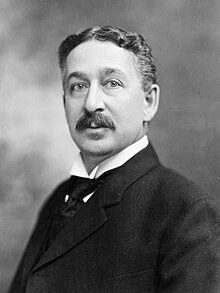King Camp Gillette
| King Camp Gillette | |
|---|---|
 |
|
| Born |
January 5, 1855 Fond du Lac, Wisconsin |
| Died | July 9, 1932 (aged 77) Los Angeles, California |
| Resting place | Forest Lawn Memorial Park Cemetery, Glendale, California |
| Nationality | American |
| Employer | Gillette Safety Razor Company |
| Spouse(s) | Alanta Ella Gaines (Oct. 12, 1868 – Aug. 28, 1951) Married 1890 |
King Camp Gillette (January 5, 1855 – July 9, 1932) was an American businessman. He invented a best selling version of the safety razor. Several models were in existence before Gillette's design. Gillette's innovation was the thin, inexpensive, disposable blade of stamped steel. Gillette is widely credited with inventing the so-called razor and blades business model, where razors are sold cheaply to increase the market for blades, but in fact he only adopted this model after his competitors did.
His ancestors came from England to Massachusetts in 1630. He was born on January 5, 1855 in Fond du Lac, Wisconsin and raised in Chicago, Illinois. His family survived the Great Chicago Fire of 1871.
While working as a salesman for the Crown Cork and Seal Company in the 1890s, Gillette saw bottle caps, with the cork seal he sold, thrown away after the bottle was opened. This made him recognize the value in basing a business on a product that was used a few times, then discarded. Men shaved with straight razors that needed sharpening every day using a leather strop. As existing, relatively expensive, razor blades dulled quickly and needed continuous sharpening, a razor whose blade could be thrown away when it dulled would meet a real need and likely be profitable.
Safety razors had been developed in the mid-19th century, but still used a forged blade. In the 1870s, the Kampfe Brothers introduced a type of razor along these lines. Gillette improved these earlier safety-razor designs, and introduced the high-profit-margin stamped razor blade steel blade. Gillette's razor retailed for a substantial $5 (about $140 in 2014 dollars) — half the average working man's weekly pay — yet sold by the millions.
The most difficult part of development was engineering the blades, as thin, cheap steel was difficult to work and sharpen. This accounts for the delay between the initial idea and the product's introduction. Steven Porter, a machinist working with Gillette, used Gillette's drawings to create the first disposable razor that worked. William Emery Nickerson, an expert machinist and partner of Gillette, changed the original model, improving the handle and frame so that it could better support the thin steel blade. Nickerson designed the machinery to mass-produce the blades.
...
Wikipedia
